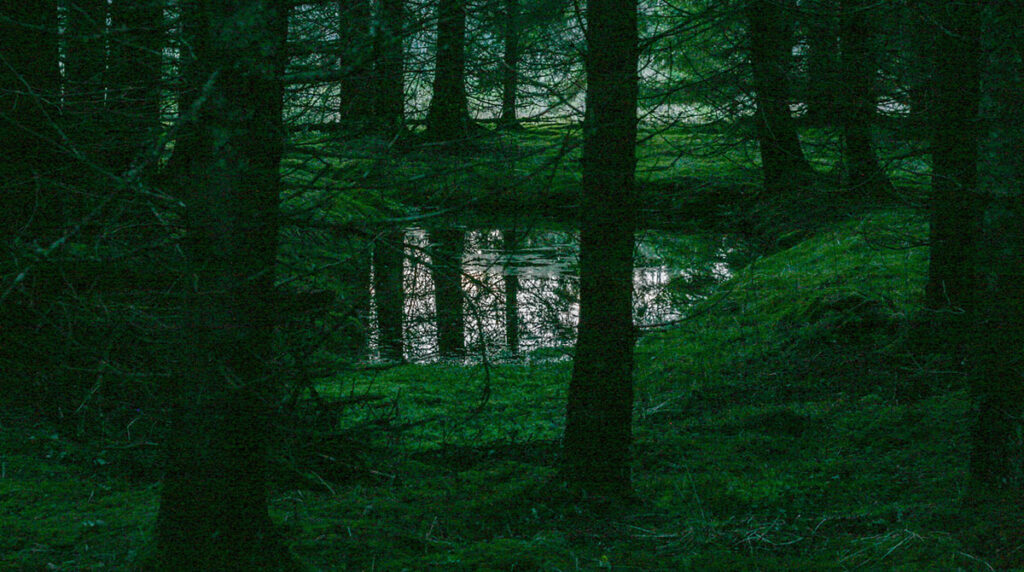
I used to love dark forests with mossy, low-hanging branches; twisting and slipping and ducking into the deep pockets of coolness in a small, tight glade was a pleasure. It was more than that—a small closed place was for me a secure place, as it was for the boy in the Japanese fairy tale “The Boy Who Drew Cats,” who kept alive by sleeping in a closet. Tunnels, dens, burrows—wonderful! In L. M. Boston’s The Children of Green Knowe, a demon tree with evil fingers did want to catch you, but I never thought of trees as unfriendly when I was a child. An armlike branch was never clutching or imprisoning but protective, drawing me close, ushering me in, making me safe.
Nowadays, I like a lone stand of trees, the trunks denuded for the first 10 feet, the canopies high overhead, the air circulating and the light wafting through as easily as a breeze, such as the stands of pino silvestre, Scots pine, with their reddish bark and high crowns, in the Parque Nacional de la Sierra de Guadarrama. Or the widely spaced encinas, oaks, I remember in the parks on the outskirts of Madrid, deer wandering among them. Here in Asturias, many forests are dense with a tangle of trees, and I, who once loved low-hanging droopy boughs, am now drawn up short by them. I’ll go around if I can and groan if I have to duck under one. I don’t mind the shadows, I’m not jumpy about creatures that scurry across my path, I don’t fear losing my way in the depths, but I hate it when I am compelled to stoop. I miss my old way of gliding through the woods, as easily as a fish through water, at home there.
After her husband’s December death, the mother of a friend now had a whole bed to herself, and her problem of arising in the middle of the night from her side, right next to the wall, to make her precarious way around the foot of the bed for a trip to the bathroom was solved by sleeping on her husband’s side. Yet on awakening in the night she was disoriented by the change. In the dark she sat on the edge of the bed—her husband’s edge—and wailed, “Where am I? What room is this? Whose house is this?” “Whose woods are these?” I might ask, or even, “Whose world is this?”
On a hot morning a few weeks ago in the town of Pravia, 45 minutes down the road from Gijón, my running partner and I chose a circular hiking trail called Ruta de los Marineros for our run. It was new for us, and we learned from a sign that it was once used by the fishmongers of Cudillero to sell their catch in the small villages along the way to Pravia.
At first we were between fields on an unpaved road, then on a rough dirt road winding through a forest, lots of eucalyptus, some chestnuts, and the ubiquitous briars. We passed through some villages—four or five stones houses, their wooden hórreos, and the old stone barns—and admired the gardens on the hillsides. The road became a grassy track climbing to some high fields before it dipped back into the woods, becoming again an easy trail. The trees were now mainly pine, and the forest lovely, shaded and cool. No low-hanging branches to duck under. On we ran. We neared the town, arriving on a hillside above it. There, on the edge of the forest, almost right on top of the houses, with just a steep descent onto a side street, we passed a cave, and from the trail we heard the gurgle of water. What a beautiful sound! Stopping, we stepped close. “Whose cave is this?” I wondered, drawn by the drip and murmur of water. Before we’d even stooped for a look inside, we realized the sound didn’t come from within but from a backhoe on a city street below us, just over the brink of the hill, rising to echo in the mouth of the cave.
So we turned away, stepped from the woods, and descended into the town without a backward glance.


